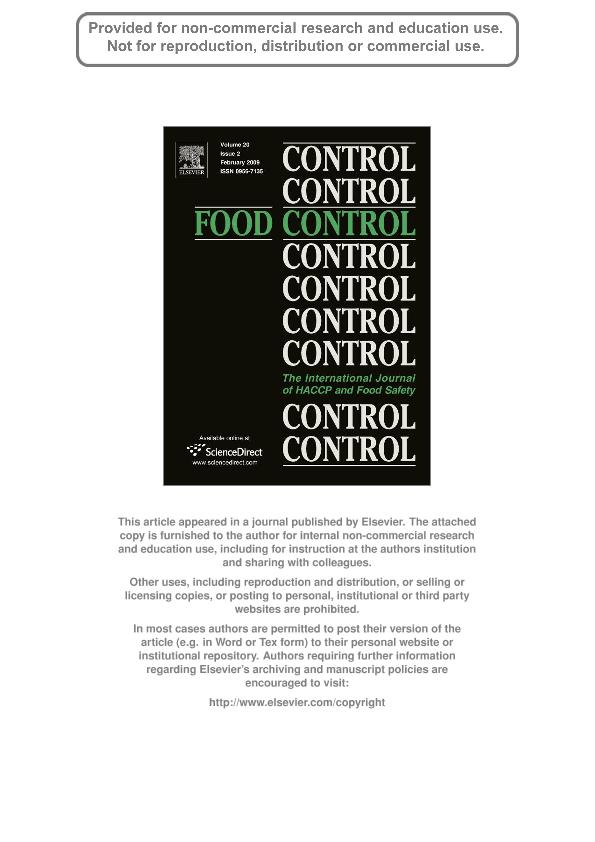Mostrar el registro sencillo del ítem
dc.contributor.author
Gerez, Carla Luciana

dc.contributor.author
Torino, Maria Ines

dc.contributor.author
Rollan, Graciela Celestina

dc.contributor.author
Font, Graciela Maria

dc.date.available
2018-07-17T21:25:02Z
dc.date.issued
2009-02
dc.identifier.citation
Gerez, Carla Luciana; Torino, Maria Ines; Rollan, Graciela Celestina; Font, Graciela Maria; Prevention of bread mould spoilage by using lactic acid bacteria with antifungal properties.; Elsevier; Food Control; 20; 2; 2-2009; 144-148
dc.identifier.issn
0956-7135
dc.identifier.uri
http://hdl.handle.net/11336/52538
dc.description.abstract
The ability of lactic acid bacteria (LAB) to inhibit Aspergillus, Fusarium, and Penicillium, the main contaminants in bread, was evaluated. Only four strains (Lactobacillus plantarum CRL 778, Lactobacillus reuteri CRL 1100, and Lactobacillus brevis CRL 772 and CRL 796) from 95 strains tested displayed antifungal activity. The major antifungal compounds were acetic and phenyllactic acids. The fermentation quotient (FQ = 2.0) and the leaven volume (80 cm3) of doughs with LB and yeasts were higher than doughs without LB. The inclusion of antifungal LAB strains in the starter culture allowed a reduction in the concentration of calcium propionate by 50% while still attaining a shelf life similar to that of traditional bread containing 0.4% CP.
dc.format
application/pdf
dc.language.iso
eng
dc.publisher
Elsevier

dc.rights
info:eu-repo/semantics/openAccess
dc.rights.uri
https://creativecommons.org/licenses/by-nc-sa/2.5/ar/
dc.subject
Antifungals Compounds
dc.subject
Bakery
dc.subject
Lactic Acid Bacteria
dc.subject.classification
Alimentos y Bebidas

dc.subject.classification
Otras Ingenierías y Tecnologías

dc.subject.classification
INGENIERÍAS Y TECNOLOGÍAS

dc.title
Prevention of bread mould spoilage by using lactic acid bacteria with antifungal properties.
dc.type
info:eu-repo/semantics/article
dc.type
info:ar-repo/semantics/artículo
dc.type
info:eu-repo/semantics/publishedVersion
dc.date.updated
2018-04-16T14:30:22Z
dc.journal.volume
20
dc.journal.number
2
dc.journal.pagination
144-148
dc.journal.pais
Países Bajos

dc.journal.ciudad
Amsterdam
dc.description.fil
Fil: Gerez, Carla Luciana. Consejo Nacional de Investigaciones Científicas y Técnicas. Centro Científico Tecnológico Conicet - Tucumán. Centro de Referencia para Lactobacilos; Argentina
dc.description.fil
Fil: Torino, Maria Ines. Consejo Nacional de Investigaciones Científicas y Técnicas. Centro Científico Tecnológico Conicet - Tucumán. Centro de Referencia para Lactobacilos; Argentina
dc.description.fil
Fil: Rollan, Graciela Celestina. Consejo Nacional de Investigaciones Científicas y Técnicas. Centro Científico Tecnológico Conicet - Tucumán. Centro de Referencia para Lactobacilos; Argentina
dc.description.fil
Fil: Font, Graciela Maria. Consejo Nacional de Investigaciones Científicas y Técnicas. Centro Científico Tecnológico Conicet - Tucumán. Centro de Referencia para Lactobacilos; Argentina
dc.journal.title
Food Control

dc.relation.alternativeid
info:eu-repo/semantics/altIdentifier/doi/http://dx.doi.org/10.1016/j.foodcont.2008.03.005
dc.relation.alternativeid
info:eu-repo/semantics/altIdentifier/url/https://www.sciencedirect.com/science/article/pii/S0956713508000716
Archivos asociados
